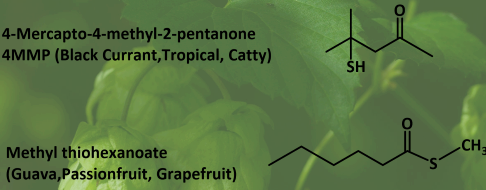A Thiol by Another Name Would Smell just as Much (Our Apologies to the Bard)

Thiols are odiferous sulfur containing molecules that can produce pleasant and unpleasant aromas. Humans are sensitive to thiols and can detect extremely low levels of thiols in food and beverages. Like many others in the hop science industry, Hoptechnic® looks at thiols as indicators of hop flavor and aroma. And if you’ve had a juicy, hazy NEIPA, West Coast IPA, or dry hopped lager, you’ve smelled and tasted what thiols can contribute to beer.
Thiols in hops can tell us a story. They can tell us when a hop is ripe for harvest, when the plants in the fields are stressed, and they can even give us an idea where a hop is grown. That’s a lot of information from some small compounds. Granted, it’s not the whole story but it was enough to start the formation of the Hoptechnic® lab as we know it.
Back in the 2010s, the lab didn’t exist as it does now. We had a single GC-MS (a gas chromatograph with tandem mass spectrometer) that we used to look at terpenes, another big part of the hop story. So there we were, tracking terpenes in hopes of getting a way to help better define harvest dates for hop fields, looking at up to 140 different terpenes in a single hop variety! This was neither easy or particularly helpful as it turns out. Two lots that were identical by terpene analysis did not perform identically in the beer, and that was a problem we needed to solve. Figure 1 shows an example of that very problem we encountered. It shows two different hop lots from two different farms in Washington State. They were harvested within the same harvest window and should have had similar aroma, especially if you take a look at the terpene chromatograms. But they don’t.type: asset-hyperlink id: c5ikj1Xj3zvJUQsfZ3pXGkh
![[object Object]](https:////images.ctfassets.net/0atzdki8v3ar/5ikj1Xj3zvJUQsfZ3pXGkh/632a7a2c5feeb47731a0e3ccc3fbd1d9/Blog1_Figs__2_.jpeg)
According to some of Sonia Collin’s work at the Université Catholique de Louvain, the aromatic difference stems from polyfunctional thiols1,2. We then switched gears, invested time and resources into an instrument capable of detecting sulfur compounds and started to dig in.
Now take a look at Figure 2. They’re the same hop lots as in Figure 1, but this time, looking specifically at the thiols fingerprints for both lots. It’s here where the differences between the hop lots shine. The compound fingerprint is similar because they are both the same variety, but we see several points of distinct differences in the signal of the compounds, which leads to differences in aroma.
![[object Object]](https:////images.ctfassets.net/0atzdki8v3ar/1LloZX6WMfqjttLhrQD0AL/3cf8bcd1648e44d8f4b41962473d16e1/Blog1_Figs__3_.jpeg)
By 2017, after a period of method development to create a GC-SCD (gas chromatography with sulfur chemiluminescence detector(3), we had a robust method based on several harvest seasons of collected data and a slightly larger lab and lab team. We were off to the races and using thiols to help steer the ship come harvest time.
There may always be a gap between sensory and thiol analysis, however, through our continued research we’ve found thiol analysis is the best way to make that gap as small as possible.
References:
1. Gros. J., Nizet, S., and Collin, S. J. Agric. Food Chem. 2011, 59, 8853-8865.
2. Gros, J., Peeters, F., and Collin, S. J. Agric. Food Chem. 2012, 60, 7805-7816.
3. Marsili, R. 2010, Consultation for VGF, Marsili Consulting Group